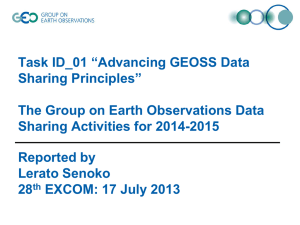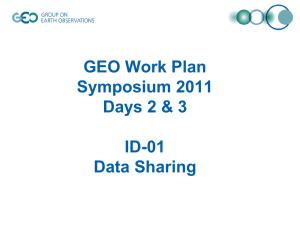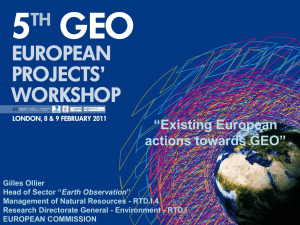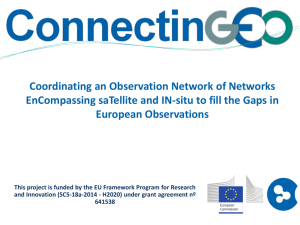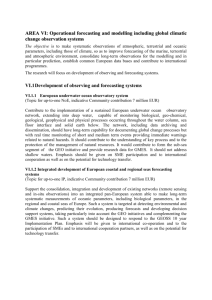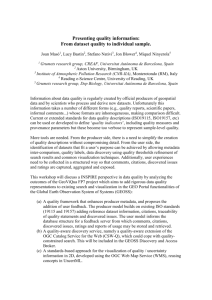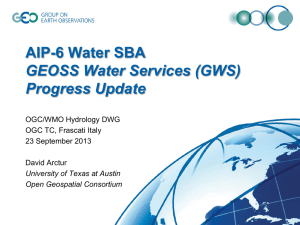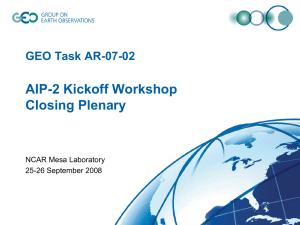20090108_GEOSS_AIP_Plenary - Federation of Earth Science
advertisement
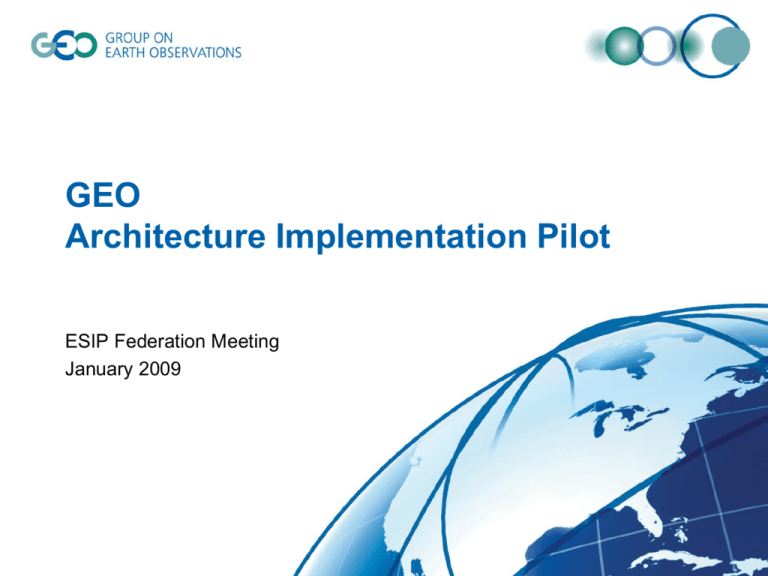
GEO Architecture Implementation Pilot ESIP Federation Meeting January 2009 GEO AIP-2 Session at ESIP Federation Architecture Implementation Pilot, Phase 2 (AIP-2) • AIP Overview – George Percivall, OGC • Access Working Group – Glenn Rutledge, NOAA • Air Quality Working Group – Stefan Falke, Northrop Grumman GEO Task AR-07-02 Architecture Implementation Pilot George Percivall, OGC January 2009 ESIP Federation Meeting GEOSS connects Observations to Decisions 4 4 Elaboration of GEOSS Architecture SBA Tasks, UIC requirements User Needs, Scenarios Design, Develop, Deploy support Operational Capability GEOSS Common Infrastructure (GCI) persistent implementation Architecture Implementation Pilot (AIP) GEOSS Interoperability Arrangements - From the GEOSS 10 Year Plan Reference Document - • Interoperability through open interfaces – Interoperability specifications agreed to among contributing systems – Access to data and information through service interfaces • Open standards and intellectual property rights – GEOSS adopting standards; agreed upon by consensus, preference to formal international standards – GEOSS will not require commercial or proprietary standards – Multiple software implementations compliant with the open standards should exist – Goal is that at least one of the implementations should be available to all implementers "royalty-free" GEO Task AR-07-02 Architecture Implementation Pilot • Lead incorporation of contributed components consistent with the GEOSS Architecture… • …using a GEO Web Portal and a GEOSS Clearinghouse search facility • …to access services through GEOSS Interoperability Arrangements • …in support of GEOSS Societal Benefit Areas Slide 7 AIP Phase 1 results in 2007 • Demonstrated effective development process: – CFP, Kickoff, Execution, etc. – Approximately 120 organizations • Established organization communication methods – For international coordination • Produced Screencasts of Initial Operating Capability • Prepared “Architecture Implementation Report” AI Pilot has broad international participation that could only have occurred with GEO. High interest & momentum supporting GEOSS vision. Slide 8 AIP Phase 2 Themes • Augment the GEOSS Common Infrastructure • Emphasize SBAs identified by UIC/ADC collaboration • Develop "persistent exemplars” • Elaborate GEOSS Architecture – Scenarios and Use Cases – Service and Component types – Interoperability Arrangements Slide 9 AI Pilot Development Approach Participation AR-07-02 Architecture Implementation Pilot Evolutionary Development Process Concept Development Participation Call for Participation Updates for each step Architecture Documentation Continuous interaction with external activities Participation Kick-off Workshop Participation Development Activities Baseline Operational Baseline and Lessons Learned for next evolutionary spiral Participation Persistent Operations (AR-07-01) AIP Phase 2 Master Schedule AIP-2 CFP Announced CFP Responses for Kickoff due Kickoff Workshop at NCAR Status to GEO Plenary 26 June 2008 1 September 2008 25-26 September 2008 November 2008 Scenarios and Use Cases defined January 2009 Scenario demonstration capture 1st Qtr of 2009 AIP-2 results transition to operations 1st Half of 2009 AIP-2 CFP Responses (37 to date) • • • • • • • • • • • • • ACRF BKG Caribbean Flood Team CIESIN CNES and ERDAS Compusult EPA AirNow ERDAS Titan ESA ESIP AQ Cluster ESRI ESRI Canada EuroCryoClim • • • • • • • • • • • • • GEONETCast GEO Grid GEO-Ukraine Giovanni ICAN ICT4EO INCOSE IP3 ISPRA JAXA KDDI Mines Paris Tech NASA World Wind • • • • • • • • • • • NOAA/NASA GOES-R and GMU CSISS NOAA IOOS NOAA NCDC NOAA SNAAP Noblis Northrop Grumman Spot Image SURA/NIMSAT/GoMO OS USGS VIEWS Washington University in St. Louis AIP-2 Kickoff Workshop, September 2008 • At NCAR Mesa Laboratory, Boulder, Colorado, USA • 85 Participants • 3 Plenary Sessions • 12 Parallel Sessions based on CFP Responses • Established Working Groups; and Development Plan AIP-2 Augmenting GCI GEOSS Common Infrastructure Main GEO Web Site Registered Community Resources Client Tier Registries GEO Web Portals Community Portals Client Applications Components & Services Standards and Interoperability Best Practices Wiki Business Process Tier GEOSS Clearinghouse User Requirements Community Catalogues Workflow Management Alert Servers Processing Servers Access Tier GEONETCast Product Access Servers Sensor Web Servers Model Access Servers AIP-2 Working Groups (WGs) • Community WGs – Disaster Response – Climate Change and Biodiversity – Renewable Energy – Air Quality • Transverse Technology WGs: – Clearinghouse, Catalogues, Registries and Metadata – Access Services: products, sensors, models – Workflow and Alerts – Portals and Application Clients – Test Facility for service registration Community WG Leaders • Disaster Response – Stuart Frye, NASA; – Didier Giacobbo, Spot Image • Health SBA: Air Quality – David McCabe, EPA – Frank Lindsay, NASA; – Stefan Falke & Rudy Husar, Washington Univ. • Biodiversity and Climate Change – Stefano Nativi, CNR; – Gary Geller, NASA/JPL • Energy SBA – Thierry Ranchin & Lionel Menard, Mines Paris Tech; – Ellsworth LeDrew, Univ Waterloo; Transverse Technology WG Leaders • • • Catalogues, Clearinghouse, Registries and Metadata – Doug Nebert, USGS; – Ted Haberman, NOAA – Kengo Aizawa, JAXA; – Josh Lieberman OGC/Traverse; Workflow and Alerts – Satoshi Sekiguchi, AIST; – Eugene Yu, GMU; – Greg Yetman, CIESIN Test Facility for service registration – Mauro Semerano, ESA • • Portals and application clients – Nadine Alameh, OGC/MobileAps; – Herve' Caumont, OGC/ERDAS Access Services: products, sensors, models – Glenn Rutledge NOAA, – Herve' Caumont, OGC/ERDAS; – Hans Peter Plag, UNR; – Anwar Vahed, ICT4EO; – Luis Bermudez SURA; Scenarios and Use Cases • Transverse Use Cases support Community Scenarios • Scenarios: end user view of the value of GEOSS – – – – Focused on topics of interest to a community Occur in a geographic Area of Interest (AOI) Steps in a scenario are Use Cases Scenarios developed by Community WGs • Use Cases: reusable service oriented architecture – Use cases for discovery, data access, etc – Utilize Interoperability Arrangements – Use Cases developed by Transverse Technology WGs Community Scenarios - Draft • Air Quality and Health: – Use of earth observations to inform three decision-makers: policy-maker, AQ compliance manager, and the public • Disasters: – Disaster cycle for Flooding events • Biodiversity and Climate Change – Polar scenario(s) – CC impact on Pikas in North America; • Renewable Energy – Site selection process for solar and wind energy Transverse Technology Use Cases - DRAFT • • • • • • • • • • Client search of metadata Visualize & Analyze Data Client access of services and alerts Publish Component and Services Bind to Services Register Resource Register Standards and Best Practices Clearinghouse Harvest and Search Construct and publish workflow Test registered service Portal / Client Portal / Client Portal / Client Access WG Access WG CCRM CCRM CCRM Workflow Testing AIP-2 Deliverables - 2009 • • • Demonstration – Demonstration of community Scenarios implemented through transverse Use Cases – Demonstrations to be recorded and made available via WWW. Engineering Reports To be considered for GEOSS Best Practice Registry – Community of Practice Scenarios, – Transverse Technology Use Cases – AIP-2 Summary Report Persistent Exemplars – Registered services (‘continuous operation’) with 99% availability (~7 hours down time a month); on a reliable network; plan for performance scaling – Nomination to operational task (AR-09-01a) References • GEO – earthobservations.org George Percivall percivall@myogc.org • GEO Architecture Implementation Pilot – www.ogcnetwork.net/AIpilot • GEOSS registries and SIF – geossregistries.info GEO AIP-2 Session at ESIP Federation Architecture Implementation Pilot, Phase 2 (AIP-2) • AIP Overview – George Percivall, OGC • Access Working Group – Glenn Rutledge, NOAA • Air Quality Working Group – Stefan Falke, Northrop Grumman GEO Architecture and Data Committee Task AR-07-02 Architecture Implementation Pilot Access Services: Products, Sensors, Models WG Access Services Co-Chairs: Glenn Rutledge, NOAA Hervé Caumont, ERDAS Luis Bermudez, SURA Terence Van Zyl, CSIR ESIP Winter Meeting January 8th, 2009 Data Product Access • 23 Primary responses: CIESIN, CNES, EPA, ESA, GEO-Ukraine, ICAN, ICT4EO, IP3, ISPRA, JAXA, Mines Paris Tech, NASA World Wind, NOAA IOOS, NOAA NCDC GOSIC, NOAA NCDC NEXRAD, NOAA NCDC NIDIS, NOAA NCDC NOMADS, NOAA/NASA GOES-R and GMU CSISS, Northrop Grumman, SURA/NIMSAT/GoMOOS, Spot Image, USGS, Washington Univ St. Louis • 15 Contributing responses: ACRF, Caribbean Flood Team, ERDAS, ESIP AQ Cluster, ESRI, ESRI Canada, NOAA SNAAP Data Product Access Topics • • • Services: WMS, WCS and WFS Broker Services: access OGC Web services, THREDDS/OPeNDAP, Encodings Formats : NetCDF/CF, GRIB, KML, GML, JPEG2000, PNGs, GeoTIFF, MrSID, Geolocated JPEGs, CADRG, CIB, Shapefile • • • • • • EO Data: Radar, Optical, Weather, Precipitation, TRMM flash flood potential ALOS Imagery: Panchromatic, Near IR, SAR General Circulation Models High-frequency radar in situ oceanographic data Coastal Web Atlas holdings • • • • • Multistandard platform (MapServer, ArcIms Server, SDE, etc) SPIDR web services IP3 ENM Species Distribution Analysis service SoDa W*S is already a Special Argmt THREDDS Sensors and Models Access • 8 Primary responses: GEO-Ukraine, ICT4EO, IP3, NOAA IOOS NOAA NCDC NOMADS, Northrop Grumman, Spot Image, SURA/NIMSAT/GoMOOS • 4 Contributing responses: Caribbean Flood Team,Compusult, NASA World Wind, NCDC NEXRAD, Noblis Goal, audience, and usage of the 'Use cases' • Use Cases are provided to model the interactions of a (sub) system under study with its environment (actors are a user interface or other system) – Co-authored by systems analysts and end users – A starting point for tests design • Use Cases are developed by the AIP Transverse Technology WG • Scenarios are developed by the AIP Community WG • Both support AI Pilot storyboards, to test & demonstrate interoperability among online persistent systems and services – Running a scenario over several systems – Activating systems functions as described in the use cases Access WG Charter • The Access WG provides coordination and guidance to achieve interoperable Access Services to products, sensors and models. • This relies on the AIP-2 particapants offerings and contributions to the pilot. • There are two priority use cases being developed by the Access WG: - Publish Component and Services - Interact with service(s) Template for Access Use Cases Simple example PublishDescription & InteractWorking Group Name Deploy Components and Services Develop and deploy a component with associated services Interact with Services Interactions between client and services for datasets, sensors, models, workflows Precondition Postcondition Access Organizational networkcapability to host accessible a service offerings Access User request for a client to access a service or alert Client received information from the service or alert A key goal is to reduce the complexity when it is not needed. This means that an “Interaction” should be similar for products, sensors , models and for workflows. 32 AIP-2 Initial Access • To succeed – initially, AIP aims to reduce the variations arising from different communities. At first cut “Bind” will be the same for everyone, then advance to a dialog on what few things need to be the same so that everything else can be different. • To the larger communities WFS, WCS, SOS, etc. are more alike than they are different. Data Access Services – OGC WCS/WMS Discovery Metadata – OGC CSW and ISO 19115/ISO 19119 Together this allows users to find and access data 33 ACCESS WG Contact Information Working Group Leads : Glenn Rutledge, Hervé Caumont, Luis Bermudez, Terence Van Zyl, Hans Peter Plag, Anwar Vahed, • Getting to the Access WG Web page: – http://sites.google.com/site/geosspilot2 • Subscribing to the Access WG Mailing List: – https://lists.opengeospatial.org/mailman/listinfo/aip_access • Access WG weekly telecons to discuss issues arising and new use cases that need to be addressed – Announcements through Access WG mailing list Global Earth Observation System of Systems (GEOSS) Architecture Implementation Pilot (AIP) Air Quality and Health Working Group Stefan Falke, Rudy Husar, Frank Lindsay, David McCabe, Erin Robinson Air Quality & Health Scenario Scenario Overview • The AQ Scenario envisions multiple types of AQ observations… • • • • satellite observations of AQ and meteorology in-situ, ambient observations models of meteorology and chemical transport other: emissions data, fire observations, LIDAR, etc. …being registered, discovered and accessed via GEOSS and used to inform diverse decision-makers: Air Quality Managers, Policy-Makers, and the Public. • Scenario community-developed ; AIP participation diverse (next slide) • Initial sub-scenario testing AIP Use Cases describes a Wildfire/Smoke event Challenges • Persistent, standardized AQ data network • Interface to GCI: Community Catalog, Portal • Implementing scenarios which can integrate the offerings using GCI-compatible Service Oriented Architecture AQ&H WG Core Participants Catalog/ Metadata EPA ESIP AQ Cluster GIOVANNI GMU NOAA NGDC Northrop Grumman VIEWS WUStL Data Access Sensors/ Models Workflow Clients Scenario Evolving Architecture AQ Community Infrastructure Portal ESA/FAO ESRI Compusult DataSpaces Metadata DB FGDC, ISO, SERF Catalog Future Considerations • Direct Access to GEOSS Clearinghouse • Community Portal/DataSpace input to GEO Portals • DataSpaces part of Community Portal? Z39.50 CS/W WAF DRAFT AQ AIP Linkages GEOSS AIP Workgroups Workflow Core AQ System AQ Apps AQ Apps AQ Apps AQ IT Cast App Provider Processing Proc. Services, Serv,Alerts Alerts CS-W, W*S AQ Community Portal Portals CS-W Applications, Clients Testing Community GEOSS Clearinghouse Catalog, Metadata CS-W AQ Community Catalog Access Services Community Capability Products, Sensors WMS WCS W*S KML Data Server Key Standards for AQ: CSW, WCS CSW – Queriable Fields for Discovery Where are we now? Where do we want to be? How to get there? WCS – Data Access Service Extensions Collaboration with UNIDATA & GALEON 4D Grids for Models, Satellite Data netCDF – CF Convention Station Time Series (STS) for Point Data netCDF – STS Convention Automatically extract discovery metadata from Capabilities & KML Community Portal • • • • A user interface between GEOSS CGI and AQ Community Catalog A content aggregator and connector Help air quality data/service providers and data/service users make use of the GEOSS Common Infrastructure Forum for dialogue among the community in shared interests in air pollution events, analysis tools, models, datasets, etc. Latest activity on AIP AQ&H WG Google Sites as RSS Help in finding and using search, visualization and analysis tools Components /Services filtered for ‘air’ from search on ESRI GEO Portal as GeoRSS Data/services metadata from DataSpaces Latest data analyses, publications, etc Development Portal: http://128.252.167.3
